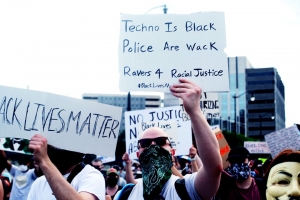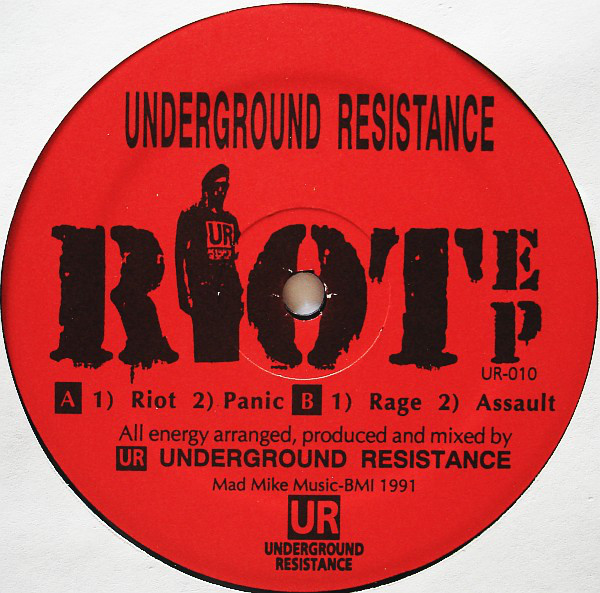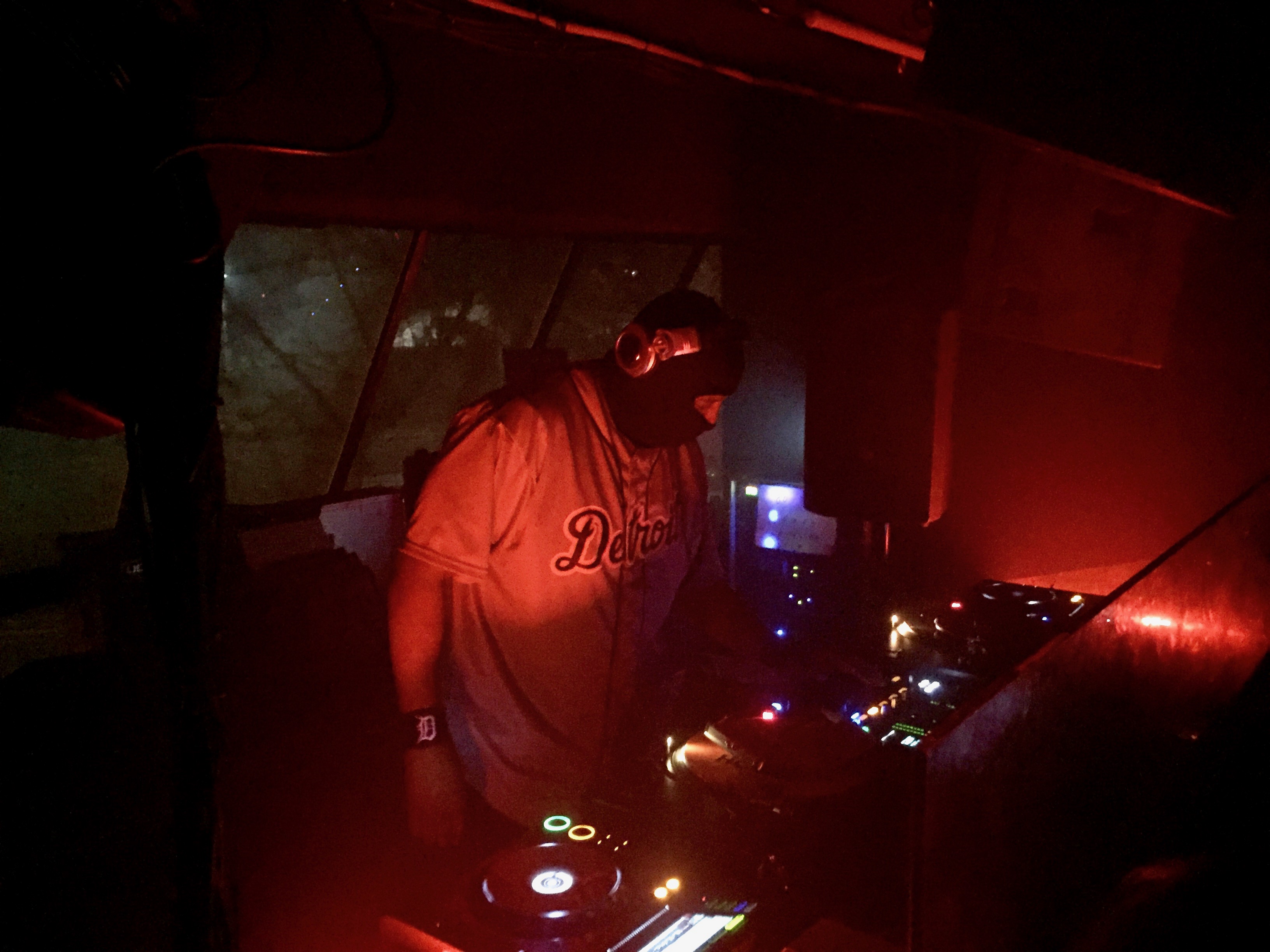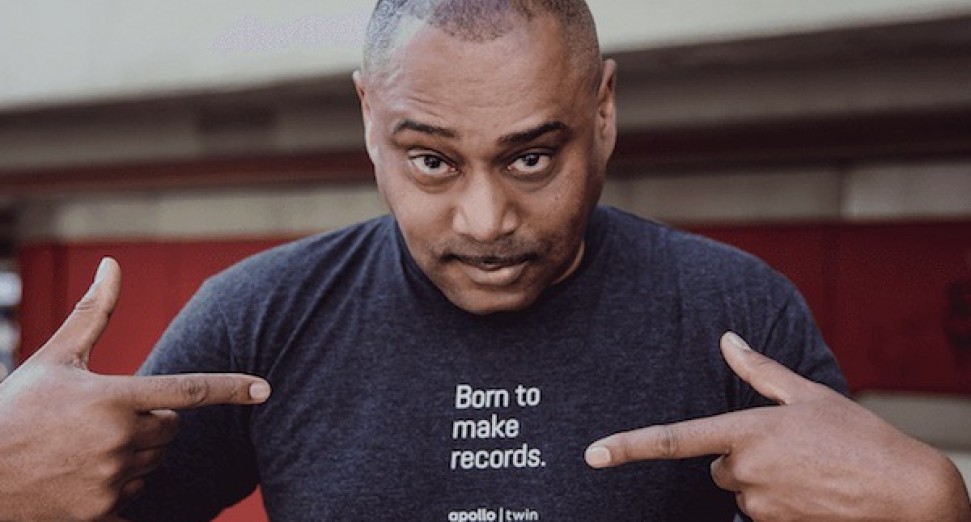
From Seoul to Detroit: Techno Amidst Protest and Pandemic
John R. Eperjesi outlines the connections between techno, COVID-19, and Black Lives Matter. The article is in memory of Mike Huckaby
So we make music. We make music about who we are and where we’re from. - Jeff Mills
We need images of tomorrow; and our people need them more than most. - Samuel Delany
Techno music is global music. Every city around the world, big or small, has a techno scene, and there are more than a few countryside techno crews out there. Seoul’s vibrant underground techno culture was recently on display, literally, with the online streaming event “VFV Club” (www.vfvclub.live/about), which brought together 22 DJs from the city’s three underground techno clubs, Vurt, Faust, and Volnost, giving people who tuned in from around the world some much-needed machine music to help them get through the coronavirus pandemic, while donations helped struggling artists and venue owners earn some desperately-needed income.

Club Directors: Yoojun (Vurt), Marcus L (Faust), Jungtak Moon (Volnost)
But while techno is now global, this music first emerged in the early 1980s in local African American communities in and around Detroit, Michigan. Detroit is a predominantly black post-industrial city that is still recovering from the flight of well-paying auto industry jobs, first to the white suburbs starting in the 1950s, and then overseas. Population and job loss, combined with racist segregation and job discrimination, has resulted in racialized patterns of inequality in which black people experience significantly higher rates of poverty and unemployment. Economic inequality, combined with underfunded public schools, health and other social services, has made cities like Detroit especially vulnerable to the COVID-19 pandemic.
And yet despite all of this, African Americans from Detroit created one of the most exciting and important genres of music to emerge in the past 40 years. A recent viral YouTube video (above) shows a motley crew of Black Lives Matter protesters in Detroit marching and chanting through the streets while techno beats blast from a stereo, similar to the way that Korean pro-democracy protests are energized by the singing, dancing, and percussion of pungmul. A handmade sign declares, “Techno is Black! Police are Wack! Ravers 4 Racial Justice!” Black Techno Matters is a local community organization that works to remind people that, “the very roots of techno were planted by black artists in Detroit”. So who are some of these artists?
History
There is some debate over which African American artists from Detroit created the first techno song, “Sharevari” by A Number of Names, or “Alleys of Your Mind” by Cybotron, both of which came out in 1981. The title of the former refers to an upscale clothing shop and party club (spelled Charevari), and captures the Europhile fantasies of upward mobility and conspicuous consumption – fine wine, Vogue, Porsche – that characterized the African American high school party scene in late 1970s and early 1980s Detroit. The latter takes dystopian tropes of science fiction, paranoia and government mind control, and unleashes them on the dance floor.
In contrast to Motown, the pop soul music institution that grew up in Detroit and left a cultural void in the city when it departed for Los Angeles in 1972, these two songs offered a new style of post-soul electronic music which drew inspiration from the robot pop of Kraftwerk, the synthesizer-driven Eurodisco of Giorgio Moroder, and the futuristic funk of hometown heroes Parliament-Funkadelic.
Also in 1981, a DJ collective, Deep Space Soundworks, began to play an eclectic mix of dance records at parties around Detroit. Three members of this collective, Juan Atkins, Derrick May, and Kevin Saunderson, are routinely venerated as the founders of Detroit techno, often referred to as the “Belleville Three,” a reference to the high school outside of Detroit where they met. But any narrative about the origins of Detroit techno that excludes Eddie Fowlkes, who was also a member of Deep Space Soundworks along with Art Payne and Keith Martin, is incomplete.
Juan Atkins had already been producing electronic music as a member of Cybotron, along with Vietnam War veteran Richard “Rik” Davis. Deciding to go solo, Atkins renamed himself Model 500 and quickly created his first solo hit, “No UFOs” (1983). This track was a hit on dance floors both in Detroit and in Chicago, where a new genre of dance music, acid house, was also incubating. After gaining attention in Chicago, the electronic music produced by Atkins, May, Saunderson, and Fowlkes began to travel across the Atlantic to dance floors in the UK and Europe. Fowlkes’s banging “Goodbye Kiss” (1986), May’s euphoric “Strings of Life” (1987), and Saunderson’s soulful hits “Big Fun” and “Good Life” (1988), all became anthems in the new rave culture that began to emerge across the Atlantic during the late 1980s.
Inspired by the immense popularity of the music coming out of the Motor City, a compilation for 10 Records in the UK was initially going to be called The New House Sound of Detroit, but when Juan Atkins’ delivered his contribution, “Techno Music,” the title of the compilation was changed to Techno! The New Dance Sound of Detroit (1988). For music critics, this new dance sound contributed to an older tradition of Afrofuturism which connected Detroit techno to the free jazz explorations of John Coltrane and Sun Ra, to the space rock of Jimi Hendrix, to black science fiction writers like Samuel Delany and Octavia Butler, and to films like John Sayles’s Brother from Another Planet (1984). On the question of why black science fiction, and by extension Afrofuturism, is important, Samuel Delany explains, “We need images of tomorrow; and our people need them more than most.”
Underground Resistance
Often described as the Public Enemy of techno, the Underground Resistance music collective and record label was started by Jeff Mills, Mike Banks, and Robert Hood in the late 1980s. Underground Resistance wanted artists to have complete artistic independence and to be protected from exploitation by record companies, and their music is wide-ranging, including everything from the gritty dystopian loops of Revolution for Change (1992), to the jazzy outer space utopianism of Galaxy 2 Galaxy (1992).

Techno DJs, producers, and fans around the world are inspired by the militancy and authenticity of Underground Resistance, and the UR symbol has become rebel chic, a Che Guevara for techno heads. The militant style of UR has been linked to the Black Panthers, an association confirmed by Jeff Mills in a 2006 interview:
All the black men you see in America today are the direct result of those actions: all the freedoms we have, as well as the restrictions, refer back to the government and the Black Panthers in the '70s . . . So we make music. We make music about who we are and where we’re from. - (Daily Yomiuri)
The title of Riot EP (UR 1991) alludes to the 1967 Detroit Uprising, also known as the Detroit Rebellion or 12th Street Riot, when the histories of racism and economic inequality erupted into clashes between black communities and the police that lasted for five days. Ideological conflicts over the naming of this event, whether it was an uprising, a rebellion, or a riot, is something that the people of Jeju and Gwangju can definitely relate to. With Black Lives Matter protests emerging all across the United States, Riot EP is once again in heavy rotation.

Mike Banks often appears in public wearing a mask, as does UR artist DJ Stingray. The mask is a symbol of resistance to the promotion of egotism and narcissism in commercial dance music culture, and visually alludes to the Mexican insurgent and former Zapatista and Indian resistance leader, Subcomandante Marcos. Mike Banks has two legacies of oppression and resistance in his family background, as his mother is Blackfoot Indian and his father is black, a biographical detail that can be heard in a song like “Ghostdancer” (1995), which refers to a resistance movement first practiced by Nevada Northern Pauite Indians in 1889 and quickly spread across the Western United States. Underground Resistance proves that you can be anti-racist and anti-imperialist and still rock a dance floor.
Protests and Pandemic
On April 24, 2020, the Detroit techno community lost one of its most beloved figures, the DJ, producer, and educator, Mike Huckaby, to complications resulting from a stroke and COVID-19. He was only 54 years old. The pandemic has devastated African American communities around the United States. Black people account for 13% of the U.S. population, yet 24% of COVID-19 deaths, nearly twice their proportion of the population.
While African American communities are fighting to survive this novel virus, a very old disease, the extrajudicial murder of black people by the police, has once again surfaced, this time in the form of an 8 minute and 46 second video of Minneapolis police officer Derek Chauvin methodically choking the life out of George Floyd, confident that he can calmly execute a black man in public and not be punished. The murder of Mr. Floyd has triggered one of the largest protest movements in the history of the United States, led by the movement Black Lives Matter.

With historic Black Lives Matter demonstrations gathering in streets and parks across the United States, and around the world, people who care about techno music, whether at home or at the club, as a critic or dancer, as a producer or DJ, should take some time to understand both this movement to end systemic racism and this history of techno, because it is all connected. The roots of techno were planted by black artists in Detroit, but those artists have often been aggressively utopian in working to imagine racially and economically egalitarian futures.
From Detroit to Seoul
Local music scenes matter too. Underground, independent, non-commercial music, from folk to techno, and from jazz to house, is the heartbeat of every community. People often go to underground dance music clubs to escape their everyday lives for a brief period of time. As the soulful disco group Sparque sang in their 1981 hit for West End Records, “Let’s Go Dancin’:”
Working hard just ain’t no good
Do something else if we only could
The only chance we get to come alive is after our nine-to-five.
As Ernst Bloch taught us, fantasies of escape are serious business, as they often contain utopian dreams of a better future. But while some people go to clubs to escape work, for others the club is a place of work. From musicians and DJs who often live gig to gig, to sound and lighting engineers, cleaning staff, door people, security, bar staff, managers, interior and graphic designers, promoters, a massive amount of labor – physical, emotional, artistic – goes into the functioning of a club.

DJ Stingray at Contra in Seoul. Photo: John Eperjesi
With clubs in Seoul and other cities around the world shut down due to the COVID-19 crisis, venue owners who have devoted their lives and pocketbooks to their passion for underground music are really hurting. But there are some signs of hope. Earlier this month, the German government announced 12-month “Restart Culture” funding initiative which will provide the coronavirus-affected creative sector as a whole with €1 billion in assistance. $56m of that total will go towards grassroots venues. Hopefully the South Korean government, which has shown remarkable compassion and leadership during this difficult time, will find a way to devote some resources toward keeping the heart of the local, underground music scene beating.

i. m. Mike Huckaby, Detroit techno legend

